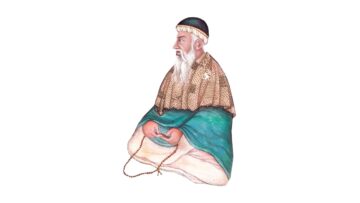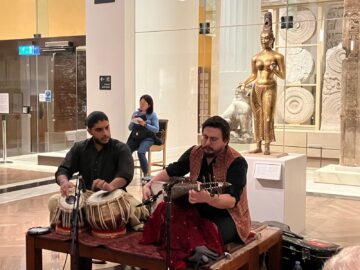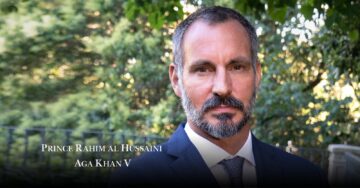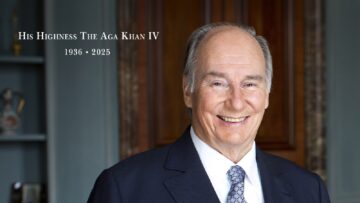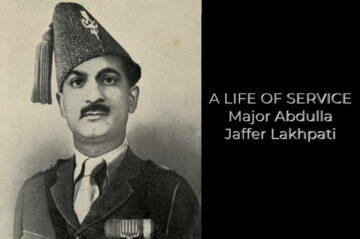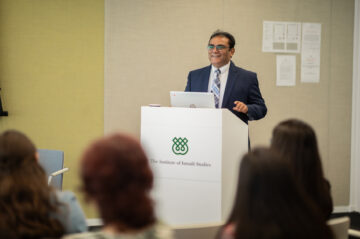This workshop was held as the Seventh Annual Summer Conference on Philosophy in the Abrahamic Traditions, sponsored by the Departments of Philosophy at the University of Denver and Marquette University and the University of Denver’s Center for Judaic Studies.
His paper entitled Al-Farabi and Ismaili Thought: Tracing Mutual Influences, dealt specifically with the possible mutual influences of al-Farabi and Ismaili thought in the areas of political philosophy, cosmology and eschatology.
In the first part of his talk, Dr Esots examined German Islamologist, Dr Hans Daiber’s claim that al-Farabi developed the principal thesis of his own political philosophy –that religion is a picture and imitation of philosophy – from the writings of Ismaili da’i Abu Hatim al-Razi (d. 322 AH / 934 CE) mainly expounded upon in his Kitab al-Islah (Book of the Correction).
The second part of Dr Esots’ talk was devoted to al-Farabi’s influence on Ismaili thought, as seen in the works of Hamid al-Din al-Kirmani, a prominent Ismaili da‘i and one of the most learned Ismaili theologians and philosophers of the Fatimid period – in particular, through his Rahat al-‘Aql (The Comfort of Reason) – in which al-Kirmani reproduces al-Farabi’s cosmological scheme of the ten intellects.
Dr Esots also examined the hypothesis of Dr Daniel De Smet about the radically different role of these intellects in both systems. Dr De Smet, he argued, rightly assumes that al-Kirmani superimposes the Farabian model on the Plotinian one, ascribing the functions characteristic of the members of the Plotinian triad to those of the Farabian decade.
He went on further to say, however, that the differences between both systems potentially go much deeper than previously assumed, since al-Kirmani, in addition to the decade of intellects, introduces a spiritual matter – and, hence, an aspect of potentiality and passivity – in his system and makes two intellects, the second and the third, issue from the first one.
The third part of Dr Janis Esots talk compared the structure of the Ismaili eschatological ‘Column of Light’ (‘amud min nur), formed by the totality of souls of believers, with that of al-Farabi’s ‘Virtuous City’(al-Madina al-Fadila); utopian perfect polity created for the purpose of guiding its inhabitants toward collective happiness (a project, inspired by Plato’s Republic). Building his argument on two passages from al-Farabi’s al-Madina al-Fadila and Siyasat al-Madina, Dr Esots claimed that, according to al-Farabi, the increase of the number of the souls freed from their physical bodies may continue infinitely. Hence, the increase of the collective happiness must be likewise infinite.
Dr Esots pointed out that a strikingly similar structure, formed by the souls separated from their material bodies and collectively enjoying an ever increasing happiness, is found in the Tayyibi sources – namely, in ‘Ali b. al-Walid’s (d. 612 AH / 1215 CE) Kitab al-Dhakhira fi’l-Haqiqa (Book of the Treasure in the Truth), where the totality of the souls of the believers, gathered in the Resurrector and constituting his form of light, is described as the ‘Column of Light’ (ʿamud min nur).
This workshop was held as the Seventh Annual Summer Conference on Philosophy in the Abrahamic Traditions, sponsored by the Departments of Philosophy at the University of Denver and Marquette University and the University of Denver’s Center for Judaic Studies.
His paper entitled Al-Farabi and Ismaili Thought: Tracing Mutual Influences, dealt specifically with the possible mutual influences of al-Farabi and Ismaili thought in the areas of political philosophy, cosmology and eschatology.
In the first part of his talk, Dr Esots examined German Islamologist, Dr Hans Daiber’s claim that al-Farabi developed the principal thesis of his own political philosophy –that religion is a picture and imitation of philosophy – from the writings of Ismaili da‘i Abu Hatim al-Razi (d. 322 AH / 934 CE) mainly expounded upon in his Kitab al-Islah (Book of the Correction).
The second part of Dr Esots’ talk was devoted to al-Farabi’s influence on Ismaili thought, as seen in the works of Hamid al-Din al-Kirmani, a prominent Ismaili da‘iand one of the most learned Ismaili theologians and philosophers of the Fatimid period – in particular, through his Rahat al-‘Aql (The Comfort of Reason) – in which al-Kirmani reproduces al-Farabi’s cosmological scheme of the ten intellects.
Dr Esots also examined the hypothesis of Dr Daniel De Smet about the radically different role of these intellects in both systems. Dr De Smet, he argued, rightly assumes that al-Kirmani superimposes the Farabian model on the Plotinian one, ascribing the functions characteristic of the members of the Plotinian triad to those of the Farabian decade.
He went on further to say, however, that the differences between both systems potentially go much deeper than previously assumed, since al-Kirmani, in addition to the decade of intellects, introduces a spiritual matter – and, hence, an aspect of potentiality and passivity – in his system and makes two intellects, the second and the third, issue from the first one.
The third part of Dr Janis Esots talk compared the structure of the Ismaili eschatological ‘Column of Light’ (‘amud min nur), formed by the totality of souls of believers, with that of al-Farabi’s ‘Virtuous City’(al-Madina al-Fadila); utopian perfect polity created for the purpose of guiding its inhabitants toward collective happiness (a project, inspired by Plato’s Republic). Building his argument on two passages from al-Farabi’s al-Madina al-Fadila and Siyasat al-Madina, Dr Esots claimed that, according to al-Farabi, the increase of the number of the souls freed from their physical bodies may continue infinitely. Hence, the increase of the collective happiness must be likewise infinite.
Dr Esots pointed out that a strikingly similar structure, formed by the souls separated from their material bodies and collectively enjoying an ever increasing happiness, is found in the Tayyibi sources – namely, in ‘Ali b. al-Walid’s (d. 612 AH / 1215 CE) Kitab al-Dhakhira fi’l-Haqiqa (Book of the Treasure in the Truth), where the totality of the souls of the believers, gathered in the Resurrector and constituting his form of light, is described as the ‘Column of Light’ (ʿamud min nur).


